Types of Migration
There are several types of migration, including:- Animal Migration: This type of migration involves the movement of animals from one place to another. Examples include the seasonal migration of birds, the migration of wildebeest in Africa, and the migration of salmon in the ocean.
- Human Migration: Human migration involves the movement of people from one place to another. This can be voluntary, such as for work or education, or involuntary, such as due to conflict or environmental factors.
- Plant Migration: While plants do not move in the same way as animals, they can also exhibit migratory behavior. This can include the dispersal of seeds by wind or animals, and the movement of plant species in response to climate change.
Reasons for Migration
There are several reasons why organisms migrate:- Seasonal Changes: Many organisms migrate in response to changing seasons. For example, birds may migrate to warmer climates in the winter to find food and suitable nesting sites.
- Reproduction: Some species migrate to specific locations to breed and give birth to their young, taking advantage of optimal conditions for offspring survival.
- Food Availability: Migration can also be driven by the need to find food. For example, grazing animals may migrate to areas with lush vegetation during the wet season, and then return to drier areas during the dry season.
- Environmental Conditions: Environmental factors such as temperature, precipitation, and daylight hours can influence migration patterns. Some species may migrate to avoid harsh conditions or take advantage of favorable ones.
Study Guide for Migration
To better understand migration, students can explore the following topics:- Research and create a presentation on a specific migratory species, detailing its migration patterns, reasons for migration, and any challenges it faces during migration.
- Discuss the impact of human activities, such as habitat destruction and climate change, on the migratory behavior of animals and plants.
- Examine the role of migration in maintaining biodiversity and ecosystem stability, and how disruptions to migration can have cascading effects on ecosystems.
- Explore the cultural, economic, and social aspects of human migration, and discuss the impact of migration on both the source and destination communities.
◂Biology Worksheets and Study Guides High School. Introduction to animals
Worksheet/Answer key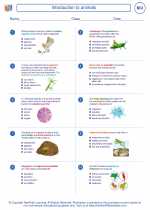 Introduction to animals
Introduction to animals  Worksheet/Answer key
Worksheet/Answer key Introduction to animals
Introduction to animals  Worksheet/Answer key
Worksheet/Answer key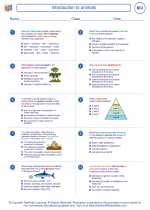 Introduction to animals
Introduction to animals  Worksheet/Answer key
Worksheet/Answer key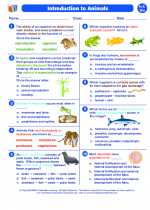 Introduction to animals
Introduction to animals  Vocabulary/Answer key
Vocabulary/Answer key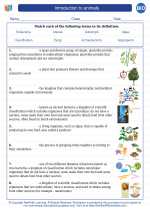 Introduction to animals
Introduction to animals  Vocabulary/Answer key
Vocabulary/Answer key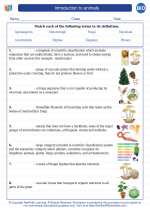 Introduction to animals
Introduction to animals  Vocabulary/Answer key
Vocabulary/Answer key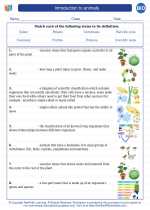 Introduction to animals
Introduction to animals 

 Worksheet/Answer key
Worksheet/Answer key
 Worksheet/Answer key
Worksheet/Answer key
 Worksheet/Answer key
Worksheet/Answer key
 Vocabulary/Answer key
Vocabulary/Answer key
 Vocabulary/Answer key
Vocabulary/Answer key
 Vocabulary/Answer key
Vocabulary/Answer key

The resources above cover the following skills:
Concepts of Life Science (SC1, SC2, SC3)
The student demonstrates an understanding of the structure, function, behavior, development, life cycles, and diversity of living organisms by describing the structure-function relationship